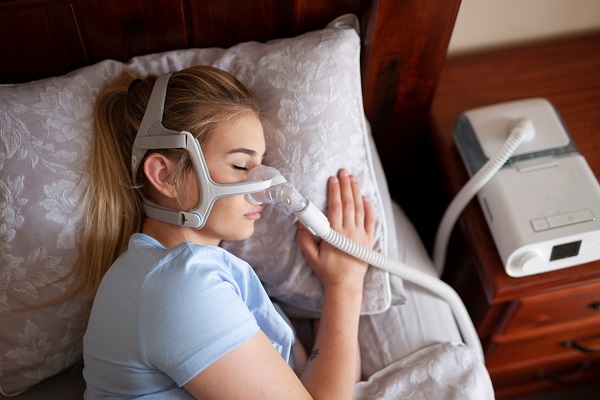What’s a CPAP device and how do I use it?

CPAP (continuous positive airway pressure) is a common treatment for sleep apnea. Your sleep physician will write a prescription for your CPAP equipment and pressure setting.
CPAP includes a small machine (smaller than a shoe box) that supplies a steady flow of pressurized air, a hose and a mask or nose piece.
Common problems with CPAP include a leaky mask, dry mouth or nose and trouble falling asleep. If you experience these or other issues, you are not alone. Many people need help adjusting to wearing CPAP.
The good news is that if one CPAP device or mask doesn’t work for you, you have other options. Most CPAP masks are adjustable, to help make them more comfortable for you.
CPAP masks
Finding the right mask for you is very important in your comfort and ability to wear CPAP. Work closely with your sleep physician and CPAP supplier to make sure you have a mask that fits you and suits your needs.
Many mask styles are available. For example, some feature full face masks that cover both your mouth and nose, with straps that stretch across your cheeks and forehead.
These may make some people feel claustrophobic, but they work well at providing a stable fit if you move around a lot during sleep.
Another choice are nasal pillows. These fit under your nose, into your nostrils, and straps cover less of your face. They may work well if you wear glasses or read with the mask on.
A nasal mask is another option; this mask fits over your entire nose and the straps stretch across your checks and forehead.
Size is important. Most masks come in different sizes, so work with your CPAP supplier to assist you in finding the right size. Ask your supplier to show you how to adjust the straps for a good fit.
Adapting to wearing CPAP
Many people have trouble getting used to wearing CPAP. It may help to start by practicing wearing the mask for short periods of time while you are awake. Then try wearing the mask with the air pressure on, still while you are awake.
Once you become accustomed to how that feels, start using CPAP during naps and every time you sleep. Inconsistently wearing CPAP may delay getting used to it.
Try your best for several weeks to see if the mask and pressure settings are right for you. If you are still having problems, call the sleep center.
Common fears with CPAP
Forced air: You may be able to decrease the feeling of “rushing air” by using the ramp feature on the CPAP machine. This feature allows you to start with a low air pressure, followed by a gradual increase in the pressure to your prescribed settings as you fall asleep.
Dry or stuffy nose: All newer CPAP devices have a heated humidifier. If your device does not have a heated humidifier, please contact your sleep physician to write you a prescription and add this to your CPAP device. Make certain your humidifier is full of water before going to bed, adjust the temperature to your comfort. The humidifier will add moisture to the pressurized air, decreasing nasal dryness.
Claustrophobic feeling: Claustrophobia (fear of confined or closed in spaces) is common with people during the first few attempts at wearing a CPAP mask. Start by holding the mask up to your face without any of the other parts and wearing the mask with straps loosely attached. Then sleep with it on once you are comfortable.
Skin irritation or pressure sores: An ill-fitting or leaky mask means you are not getting the full air pressure you need, and the mask may be irritating your skin. Try adjusting the straps or pads to get a better fit. You also need to wash your mask with warm, soapy water on a daily basis.
Dry mouth: If you normally breathe through your mouth while sleeping or your mouth falls open during sleep, CPAP may increase dry mouth. Using a heated humidifier and a full-face may work better for you.
Trouble falling asleep: This is a normal and a temporary problem. Try wearing the mask alone for brief times during the day. This may help you get accustomed to how it feels.
Noise: All newer CPAP devices are almost silent, but if you find the noise bothersome, first check to make sure the air filter is clean and unblocked. If this does not help, have your CPAP supplier check the device and make certain it’s working properly.
Removing the CPAP mask during the night: It’s not uncommon to wake up to find you have removed the mask in your sleep. If you move a lot in your sleep a full-face mask will stay on your face better. A chin strap may also help keep the mask on your face.
Still have questions? Learn more from our team at the Salem Health Sleep Center about how we can help you get well-rested again.